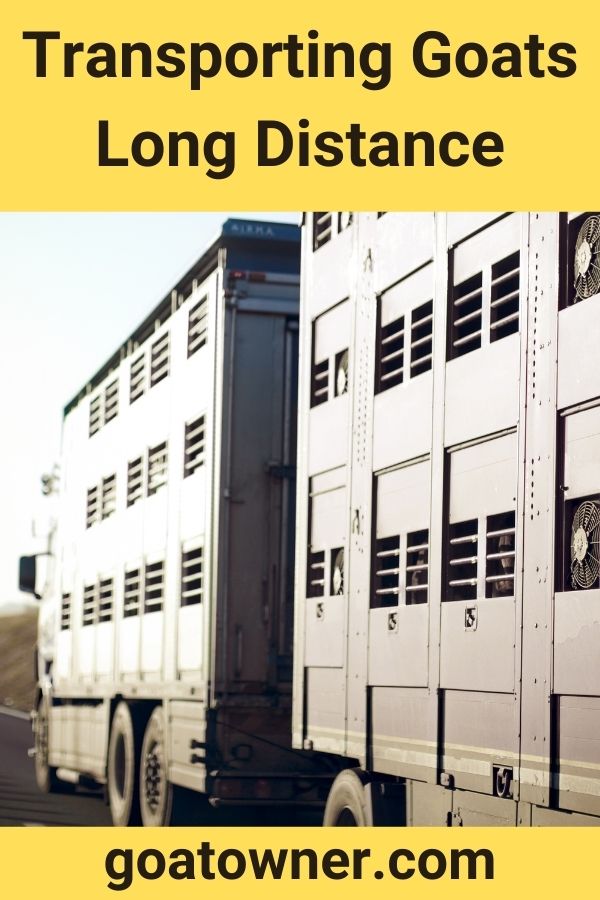My usual vet is out of town at the moment, and I’m having a bit of a medical emergency.
One of my goats is showing signs of an infection, and I want to get him seen to have it confirmed as soon as possible.
The only other vet I can find nearby who will see my goats is over 100 miles away, and he doesn’t do house calls.
I’m going to need to transport my goat long distance, then—but is this safe?
How can I do it?
I decided to look into it.
Transporting goats long distance – can you do it?
Goats can be safely transported over long distances, with the right care. You’ll ideally need a livestock carrier, with food and water to last them the journey, and bedding to lie in. Moving goats is a pretty delicate affair, so you must go in with a careful plan.
Transporting goats isn’t like taking your dog out.
They can’t just jump in the back of the car and go.
You’ll need some dedicated hardware and a carefully plotted plan to get them from point A to B.
That said, it’s still entirely safe and doable.
Let’s look further into this
Can you transport goats long distances?
Yes, you can.
The important point, though, is that you’ve got to be very careful about how you do it.
I’ll get into the nuts and bolts of how shortly, but before you even think about actually moving them, you need to think about the specifics of your journey.
Firstly, exactly how long distance are you considering?
Most goats can be comfortably driven for around 5-6 hours without you really needing to make a stop to check on them.
More than 10 hours, and you’re going to need to think about stops along the way.
You may also need to separate your goats, even if it means making multiple trips.
You can’t transport kidding does with other goats, for instance, nor can you really transport several males at a time.
So, yes, you can transport goats long distance.
But it’s going to take time and careful planning.
So, let’s look at exactly how to do it.
How do you transport goats long distances?
Firstly, how many goats are you moving?
If you are only moving one or two, then your options are certainly less limited.
For this, you can potentially even use a truck bed. It will need to be sealed on all sides, and this isn’t really ideal for anything longer than a couple of hours.
But it is an option.
For any considerable number of goats, though, you’re going to most likely need a livestock carrier.
This would be a dedicated housing trailer designed for moving animals.
This would give them adequate space on the journey, and with the right trailer you could move as many as a dozen goats at once.
You need to make sure all their needs are met, though.
They will need plenty of fresh food and water for the journey.
Again, be careful about the individuals that you’re mixing.
As I said also, if the journey is going to be longer than around 10 hours, then you should make plans to stop somewhere and check on the goats.
They will most likely be fine, but it’s best to be certain.
So, depending on the length of the journey, your best bet is a livestock carrier or a truck bed for a smaller operation.
But how far can we actually move them?
How long can you transport animals for?
A single journey without giving them time to relax and roam a pasture really shouldn’t go for more than 16 or so hours.
You should still make plans to stop along the way, but you can safely move them for this long in a single journey.
Any more than that, and the goats will start to get really restless, and it could lead to aggressive behavior.
If you need to move them further than this, try to find a half-way house.
Somewhere you can stop and let them roam for a day or so.
This will make the rest of the journey much easier on them.
Does a van work for transport?
Can you transport goats in a van?
Again, assuming the van is a sufficient size, and you properly prepare it, a van shouldn’t be a problem.
The main issue is going to be light—they shouldn’t ideally be left in the dark.
So, assuming it has windows, you can throw some bedding in there, and make sure the number of goats you’re moving have the space to lie down and move around.
Then, make sure they are provided sufficient food and water to last them the whole journey.
If you can make all these allowances, then the van will be a great option.
Ideally, as I said, you would always move them in a livestock carrier since this will give better air circulation—that’s the main issue with a van.
So, again, it’s important to stress the need for careful planning.
Things can go seriously wrong when transporting goats long distances if you don’t make enough allowances for unexpected circumstances.
Moving goats long distances is entirely doable, in a way that minimizes stress to the goat.
That said, you’ve really got to have some idea of what you’re doing before you even get started.
Armed with the knowledge I’ve given you here, you’re off to a great start.

